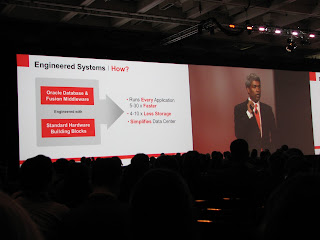The day started off with a keynote featuring Joe Tucci from EMC, Mark Hurd and Thomas Kurian. I won't say much about the keynote, i'm sure more than enough analysis has been already done. All I will say tho, similar to last evening, the focus was too heavy on hardware and the "Exa's". Oracle has sold a thousand of these servers and plan to sell 3000 over the next year. While impressive, it still means that the majority of customers currently don't have Exa servers in house. So, in my humble opinion, the keynotes should try to appeal to a wider audience.
First up I had a hand's on lab, Using Oracle Application Management Suite for Oracle E-Business Suite. We just purchased this pack and plan on implementing it over the next few months. The lab had a few issues, some my own fault, some with the environment. It was only an hour long and given the amount of material in the guide i'm not sure if the goal was for us to complete it all. Really to cover the amount of material they had listed you would need at least half a day. One good thing tho is that they offered to email us the documentation (or copy it if you had a USB key) so we could continue/read up on it on our own time.
Next I attended Who Ate My DB Time? Advanced Techniques for Database Performance Analysis. It was a good presentation. It covered some new features of OEM R12 and how they work behind the scenes. It finished with a customer testimonial from Boeing.
Automating Patching with Oracle Application Management Suite for Oracle E-Business Suite, covered features from both the application management pack and change management pack. Monitoring, lifecycle management, configuration management, etc. Being able to compare two instances from profile options to context values. AMP for 12c is still under development, so if you use this pack you won't be upgrading to the new OEM version right away. The customer testimonial by Prithwi Barman at the end was very interesting. I know that before we can even use AMP we need to apply the latest ATG patches plus various others. But after hearing him talk it looks like its going to take a fair bit more effort than I thought. I didn't add it up, but it took them quite a few man months to implement it from DEV to PROD and test features such custom patches.
Prithwi also talked about the process they follow migrating patches and displayed a chart summarizing the process flow. Alot of time goes into building these flows so its always nice to see how other companies do this. It helps give you a kickstart designing your own and/or justifing some of the choices you make.
For example, in the attached slide you can see that the developers package the custom patches, pass them along through an approval layer before reaching the DBA's. This makes perfect sense to me but I know will make a difficult sell. Being able to say X company is doing it this way for Y and Z reasons is going to help alot.
The next session I attended was Maximize Efficiency of Oracle E-Business Suite 11i and 12 Through Diagnostics. Not something that really falls under my responsibility other than to make sure its setup. So my main goal was just to get some more information on how its used by developers, some issues they may encounter etc. Quite frequently when they open an SR oracle asks them to run various diagnostics reports and upload them.
It was very beneficial, the presenter Karen Brownfield, talked about some security issues such as the CRM HTML administration role having super user access to diagnostics. How tests in 11i timeout after 5 minutes, RDA's timeout in R12. Features such as save sets and groups. If you have a set of tests you plan to execute at the same time frequently you can put them in a save set. Groups are similar but available to all users instead of just the one who created it.
Last but not least was Oracle E-Business Suite Directions: Deployment and System Administration. Features in the next version of R12 (12.2) include a dual file system which allows online patching to occur. Basically two appltops are installed, the application runs out of one of them (runtime appltop) while patches are applied to the other (patch appltop). Once patching is complete a brief downtime occurs during the switch over. Downtime is predictable, minutes not hours/days.
The benefits of switching the application tier over to Weblogic were also explained. WLS has strong support for high availability and failover. Consolidated administration, configuration and deployment. A very indepth troubleshooting framework. Comprehensive, low-overhead application and diagnostics.
A brief stop by the OTN party and then supper with an old co-worker. We haven't seen each other in years even tho we live in the same city. We were actually on the same flight and ran into each other after deplaning in San Francisco.




No comments:
Post a Comment